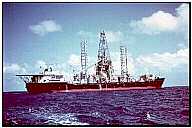Project Jennifer
Hughes Glomar Explorer
 The Hughes Glomar Explorer [HGE] was built in 1973 by Sun Shipbuilding and Drydock Co. for an intricate CIA undertaking. The mission of Glomar Explorer was to raise a Soviet nuclear submarine that had sunk in the Pacific, resting on the ocean floor nearly 17,000 ft. (5,200 m) down. The Soviet Golf-II Class ballistic missile submarine sank on April 11, 1968, approximately 750 miles northwest of Hawaii. Naval intelligence at Pearl Harbor had tracked the submarine and learned of its fate through underwater listening devices. After months of futile searching by Soviet vessels, it became apparent that only the US knew the location of the sunken submarine.
The Hughes Glomar Explorer [HGE] was built in 1973 by Sun Shipbuilding and Drydock Co. for an intricate CIA undertaking. The mission of Glomar Explorer was to raise a Soviet nuclear submarine that had sunk in the Pacific, resting on the ocean floor nearly 17,000 ft. (5,200 m) down. The Soviet Golf-II Class ballistic missile submarine sank on April 11, 1968, approximately 750 miles northwest of Hawaii. Naval intelligence at Pearl Harbor had tracked the submarine and learned of its fate through underwater listening devices. After months of futile searching by Soviet vessels, it became apparent that only the US knew the location of the sunken submarine.
Oceanographers have long known that parts of the Pacific sea floor at depths between 14,000 ft. and 17,000 ft. are carpeted with so-called manganese nodules, potato-size chunks of manganese mixed with iron, nickel, cobalt and other useful metals. In the 1970s, Howard Hughes used the Deep Ocean Mining Project [DOMP] search for nodules as a cover for building the ship Glomar Explorer. Global Marine supervised construction of the Glomar Explorer , at a cost in excess of $200 million dollars, and operated it from 1973 to 1975 under contract to the US government. Glomar Explorer went to sea on June 20, 1974, found the sub, and began to bring a portion of it to the surface. The Soviets watched the "deep-sea mining" operation with interest, but did not attempt to thwart it. An accident during the lifting operation caused the fragile hulk to break apart, resulting in the loss of a critical portion of the submarine, its nuclear missiles and crypto codes. However, according to other accounts, material recovered included three nuclear missiles, two nuclear torpedoes, the ship's code machine, and various code books.
From 1978 to 1980, Global Marine operated the ship in a deep-ocean mining test in water depths to 17,000 feet. The Explorer, which is 619 feet long and 116 feet wide, is owned by the US Navy. With the exception of the brief stint as a manganese module miner, the vessel has since been mothballed with the Naval Reserve Fleet in Suisun Bay CA, where it could be seen by cars crossing the Benicia bridge on U.S. Highway 680 east of San Francisco. After years of being mothballed, the ship was recently taken to Hunters Point Naval Shipyard for commercial modifications, including the removal of an 840-ton gimbal and a 608-ton cage. The vessel is on a 30-year lease from the US Navy to Global Marine Drilling, and recently underwent a large conversion project to one of a kind deep sea drill ship. Conversion cost over $180 million and was completed during the first quarter of 1998. Glomar Explorer was equipped to drill in waters of 7500 feet and with some modification up to 11,500 feet, which is 2,000 feet more than any existing rig. The conversion included the removal of 25 million pounds of superstructure and equipment to prepare the vessel for its conversion to a a dynamically-positioned deep sea drilling ship. Houston-based Global Marine is one of the largest worldwide offshore drilling contractors, with a five-year commitment from two major oil companies for drilling in water depths up to 7,500 feet in the US Gulf of Mexico. The Los Angeles Times broke the story in February 1975, and by March 1975 numerous news stories linked the Hughes Glomar Explorer, a ship publicly listed as a research vessel owned and operated by Summa Corporation, and the secret US government operation. After subsequent stories that the CIA had approached the news media to convince them to discontinue publication of stories related to the Glomar Explorer, Harriet Ann Phillippi, a journalist, filed a FOIA request with the CIA for any records that might exist which reveal the CIA�s contact with members of the media to attempt to persuade them not to publish articles concerning the activities of the Glomar Explorer. The CIA responded by refusing to neither confirm nor deny the existence of any responsive records. The CIA claimed that any records that might exist which may reveal any CIA connection with or interest in the activities of the Glomar Explorer, or any evidence that might reveal the existence of records of this type would be classified, and therefore, exempt from disclosure under exemption 1 of the FOIA. They also insisted that exemption 3 applied, as the National Security Act of 1947 precluded them from releasing information related to the functions of CIA personnel. This was the first instance of an agency using the "can neither confirm nor deny" answer in response to a FOIA request. Since then, the terms "Glomar response," and "Glomarization" are used to describe an agency�s response when they can neither confirm nor deny whether records exist.Specifications | |
| Length, o.a. | 618.8 ft. (188.6 m) |
| Beam | 115.8 ft. (35.3 m) |
| Depth | 51 ft. (15.5 m) |
| Draft | 35 ft. (10.7 m) |
| Displacement | 50,500 lt |
| Maximum water depth | 10,000 ft. |
| Maximum wind speed | 100 knots |
| Maximum drilling depth | 30,000 ft. |
| Extimated speed at full load | 10 knots |
Sources and Resources
- Review of David H. Sharp, "The CIA's Greatest Covert Operation: Insider the Daring Mission to Recover a Nuclear-Armed Soviet Sub" by Jeffrey Richelson, H-DIPLO, October 14, 2012
- Project Azorian: The CIA's Declassified History of the Glomar Explorer, National Security Archive, February 12, 2010
- Notice of Availability for Donation of the Test Craft Ex-SEA SHADOW (IX-529) and Hughes Mining Barge (HMB-1), Federal Register, September 14. "The Department of the Navy hereby gives notice of the availability for donation, under the authority of 10 U.S.C. 7306, of the Test Craft ex-SEA SHADOW (IX 529) and the Hughes Mining Barge (HMB-1)."
- The Jennifer Project by Clyde W. Burleson
- Matter of Risk : The Incredible Inside Story of the CIA's Hughes Glomar Explorer Mission to Raise a Russian Submarine by Roy D. Varner


